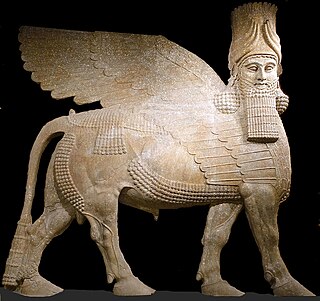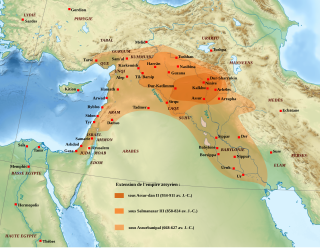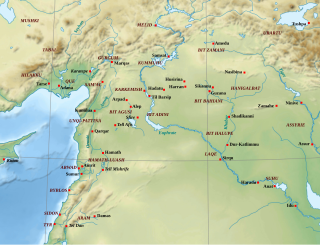
Assyria was a major ancient Mesopotamian civilization which existed as a city-state from the 21st century BC to the 14th century BC, then to a territorial state, and eventually an empire from the 14th century BC to the 7th century BC.

Babylonia was an ancient Akkadian-speaking state and cultural area based in the city of Babylon in central-southern Mesopotamia. It emerged as an Akkadian populated but Amorite-ruled state c. 1894 BC. During the reign of Hammurabi and afterwards, Babylonia was retrospectively called "the country of Akkad", a deliberate archaism in reference to the previous glory of the Akkadian Empire. It was often involved in rivalry with the older ethno-linguistically related state of Assyria in the north of Mesopotamia and Elam to the east in Ancient Iran. Babylonia briefly became the major power in the region after Hammurabi created a short-lived empire, succeeding the earlier Akkadian Empire, Third Dynasty of Ur, and Old Assyrian Empire. The Babylonian Empire rapidly fell apart after the death of Hammurabi and reverted to a small kingdom centered around the city of Babylon.
Adad-nīrārī II reigned from 911 BCE to 891 BCE. He was the first King of Assyria in the Neo-Assyrian empire. He instigated the first renewed period of major expansion following that of the Middle Assyrian Empire which had begun in 1365 BCE under Ashur-uballit I and ended after the death of Ashur-bel-kala in 1053 BCE.

Tukulti-Ninurta I was a king of Assyria during the Middle Assyrian Empire. He is known as the first king to use the title "King of Kings".
Aššūr-bēl-kala, inscribed maš-šur-EN-ka-la and meaning “Aššur is lord of all,” was the king of Assyria 1074/3–1056 BC, the 89th to appear on the Assyrian Kinglist. He was the son of Tukultī-apil-Ešarra I, succeeded his brother Ašarēd-apil-Ekur who had briefly preceded him, and he ruled for 18 years He was the last king of the Middle Assyrian Empire, and his later reign was preoccupied with a revolution against his rule led by one Tukulti-Mer, which, by the end of his reign, allowed hordes of Arameans to press in on Assyria's western borders. He is perhaps best known for his zoological collection.
Aššur-rēša-iši I, inscribed maš-šur-SAG-i-ši and meaning “Aššur has lifted my head,” ruled 1132–1115 BC, son of Mutakkil-Nusku, was a king of Assyria, the 86th to appear on the Assyrian King List and ruled for 18 years. The Synchronistic King List and its fragmentary copies give him as a contemporary of the Babylonian kings Ninurta-nādin-šumi, Nebuchadnezzar I and Enlil-nādin-apli, although the last of these is unlikely per the commonly accepted chronology.
Ninurta-tukultī-Aššur, inscribed mdNinurta2-tukul-ti-Aš-šur, was briefly king of Assyria c. 1132 BC, the 84th to appear on the Assyrian Kinglist, marked as holding the throne for his ṭuppišu, "his tablet," a period thought to correspond just to the inauguration year. He succeeded his father, the long-reigning Aššur-dān I, but the throne was very quickly usurped by his brother, Mutakkil-Nusku, and he was driven from Assur and sought refuge in the city of Sišil, on the Babylonian border, the scene of the final dénouement.
Aššur-dān I, mAš-šur-dān(kal)an, was the 83rd king of Assyria, reigning for 46 years, c. 1178 to 1133 BC, and the son of Ninurta-apal-Ekur, where one of the three variant copies of the Assyrian King List shows a difference. The Synchronistic King List and a fragmentary copy give his Babylonian contemporaries as Zababa-šum-iddina, c. 1158 BC, and Enlil-nādin-aḫe, c. 1157—1155 BC, the last of the kings of the Kassite dynasty, but it is probable he was contemporary with two more preceding and two following these monarchs, if the length of his reign is correct.
Aššūr-nādin-apli, inscribed maš-šur-SUM-DUMU.UŠ, was king of Assyria. The alternate dating is due to uncertainty over the length of reign of a later monarch, Ninurta-apal-Ekur, where conflicting king lists differ by ten years. His name meant "Aššur is the giver of an heir" in the Akkadian language. He was a son of Tukulti-Ninurta I.
Aššur-nerari III, inscribed maš-šur-ERIM.GABA, “Aššur is my help,” was king of Assyria. He was the grandson of Tukulti-Ninurta I and might have succeeded his uncle or more probably his father Ashur-nadin-apli to the throne, who had participated in a conspiracy against Tukulti-Ninurta I which led to his murder.

Kaštiliašu IV was the twenty-eighth Kassite king of Babylon and the kingdom contemporarily known as Kar-Duniaš, c. 1232–1225 BC. He succeeded Šagarakti-Šuriaš, who could have been his father, ruled for eight years, and went on to wage war against Assyria resulting in the catastrophic invasion of his homeland and his abject defeat.

The history of the Assyrians encompasses nearly five millennia, covering the history of the ancient Mesopotamian civilization of Assyria, including its territory, culture and people, as well as the later history of the Assyrian people after the fall of the Neo-Assyrian Empire in 609 BC. For purposes of historiography, ancient Assyrian history is often divided by modern researchers, based on political events and gradual changes in language, into the Early Assyrian, Old Assyrian, Middle Assyrian, Neo-Assyrian and post-imperial periods., Sassanid era Asoristan from 240 AD until 637 AD and the post Islamic Conquest period until the present day.

Ashur, Ashshur, also spelled Ašur, Aššur was the national god of the ancient Assyrians until their gradual conversion to Christianity between the 1st and 5th centuries AD.

The Neo-Assyrian Empire was the fourth and penultimate stage of ancient Assyrian history. Beginning with the accession of Adad-nirari II in 911 BC, the Neo-Assyrian Empire grew to dominate the ancient Near East throughout much of the 8th and 7th centuries BC, becoming the largest empire in history up to that point. Because of its geopolitical dominance and ideology based in world domination, the Neo-Assyrian Empire is by many researchers regarded to have been the first world empire in history. It influenced other empires of the ancient world culturally, governmentally, and militarily, including the Babylonians, the Achaemenids, and the Seleucids. At its height, the empire was the strongest military power in the world and ruled over all of Mesopotamia, the Levant and Egypt, as well as parts of Anatolia, Arabia and modern-day Iran and Armenia.

The Middle Assyrian Empire was the third stage of Assyrian history, covering the history of Assyria from the accession of Ashur-uballit I c. 1365 BC and the rise of Assyria as a territorial kingdom to the death of Ashur-dan II in 912 BC. The Middle Assyrian Empire was Assyria's first true period of ascendancy as an empire, although Assyrian kings had existed from perhaps as early as the 25th century BC, and from the 21st century BC Assyria had controlled trading colonies in Anatolia and had economic and military influence in Southern Mesopotamia, and from the late 19th century BC had been an integral part of the "Empire of Shamsi-Adad", sometimes called the Old Assyrian Empire. Though the empire experienced successive periods of expansion and decline, it remained the dominant power of Mesopotamia and often the entirety of West Asia throughout the period. In terms of Assyrian history, the Middle Assyrian period was marked by important social, political and religious developments, including the rising prominence of both the Assyrian king and the Assyrian national deity Ashur.

Adad-šuma-uṣur, inscribed dIM-MU-ŠEŠ, meaning "O Adad, protect the name!," and dated very tentatively c. 1216–1187 BC, was the 32nd king of the 3rd or Kassite dynasty of Babylon and the country contemporarily known as Karduniaš. His name was wholly Babylonian and not uncommon, as for example the later Assyrian King Esarhaddon had a personal exorcist, or ašipu, with the same name who was unlikely to have been related. He is best known for his rude letter to Aššur-nirari III, the most complete part of which is quoted below, and was enthroned following a revolt in the south of Mesopotamia when the north was still occupied by the forces of Assyria, and he may not have assumed authority throughout the country until around the 25th year of his 30-year reign, although the exact sequence of events and chronology remains disputed.

The timeline of ancient Assyria can be broken down into three main eras: the Old Assyrian period, Middle Assyrian Empire, and Neo-Assyrian Empire. Modern scholars typically also recognize an Early period preceding the Old Assyrian period and a post-imperial period succeeding the Neo-Assyrian period.

Bit-Zamani is an ancient Aramean state in northern Mesopotamia, located within the mountainous region of Tur Abdin. In Bit-Zamani was the city of Amida. It was one of the four Aramean states that bordered Assyria. The others were Bit-Halupe, Bit Bahiani and Laqe. By the ninth century BC all of them lost to Assyria.

King of the Four Corners of the World, alternatively translated as King of the Four Quarters of the World, King of the Heaven's Four Corners or King of the Four Corners of the Universe and often shortened to simply King of the Four Corners, was a title of great prestige claimed by powerful monarchs in ancient Mesopotamia. Though the term "four corners of the world" does refer to specific geographical places within and near Mesopotamia itself, these places were thought to represent locations near the actual edges of the world and as such, the title should be interpreted as something equivalent to "King of all the known world", a claim to universal rule over the entire world and everything within it.
The Babylonian–Assyrian War of 1235 BCE was a military conflict that took place around 1235 BCE. It was fought between Babylonia led by Kashtiliash IV and Assyria led by Tukulti-Ninurta I. The war ended with Assyrian victory.












